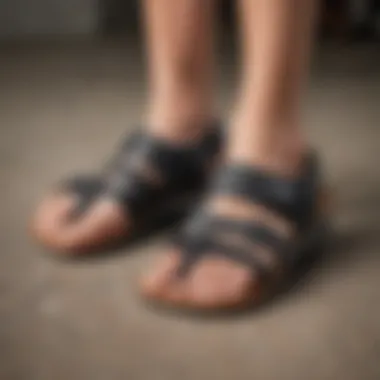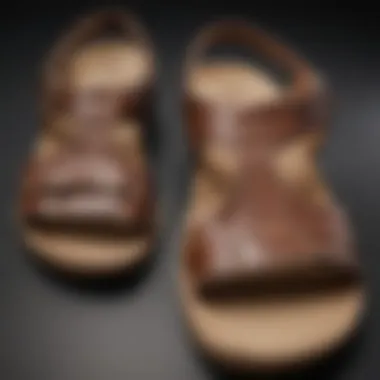Best Sandals for Back Support: A Comprehensive Guide


Intro
When it comes to footwear, many people overlook the significance of choosing the right sandals. Footwear can dramatically affect not only foot comfort but also spinal health in the long run. This guide provides a detailed analysis of supportive sandals, focusing on their impact on back health. Readers will understand why investing in quality sandals is essential for maintaining good posture and alleviating back pain.
Additionally, we will explore the various features that contribute to back support. Incorporating insights from expert recommendations, popular brands, and practical tips, this article aims to help individuals make well-informed footwear choices.
Importance of Supportive Footwear
Wearing the right sandals can influence not only how you walk but also your spinal alignment. A supportive sandal offers features such as arch support, cushioning, and proper fit. These elements work together to facilitate healthy movements. A lack of support can lead to chronic pain, affecting one’s daily life.
The Anatomy of a Supportive Sandal
Understanding the anatomy of sandals helps in recognizing what features to look for. Key components include:
- Arch Support: Essential for balancing weight distribution and improving posture.
- Cushioning: Provides comfort and absorbs shock, reducing strain on the back.
- Adjustable Straps: Ensure a custom fit, accommodating individual foot shapes.
- Sole Material: Should offer good traction and durability for varied surfaces.
Selecting sandals with these features contributes significantly to overall foot and back health.
Popular Brands and Styles
Considering various brand options is crucial when looking for supportive sandals. Brands like Teva, Keen, Birkenstock, and Ecco stand out for their dedication to providing comfort and support. Each of these brands incorporates unique technology aimed at enhancing the user's experience.
- Teva: Known for adjustable sandals with substantial arch support and shock-absorbing bases.
- Keen: Offers sturdy sandals that excel in outdoor conditions while ensuring foot stability.
- Birkenstock: Features contoured footbeds that evenly distribute pressure, promoting healthy posture.
- Ecco: Combines style with functionality, ensuring quality and comfort.
When evaluating styles, look for those dedicated to a mix of aesthetics and comfort features. Reading consumer reviews can also reveal insights about real-life effectiveness.
Practical Tips for Selecting the Right Sandal
Choosing the best sandals requires careful consideration. Here are some practical tips that aid in the selection process:
- Try Before You Buy: Always test sandals in-store if possible. Walk a few steps to evaluate comfort.
- Check Return Policies: Investing in sandals means you should ensure options to exchange if they don't work out post-purchase.
- Prioritize Your Needs: Assess which features are most important for your lifestyle.
- Follow Up With Reviews: Researching brands and models online can clarify user satisfaction before buying.
Understanding the Relationship Between Footwear and Back Health
Footwear plays a crucial role in maintaining good back health. Often, people focus on the upper body aspect of their skeletal system while neglecting the feet's position and mobility. The right sandals not only support the foot but also align the spine, which can help alleviate chronic pain.
Using appropriate sandals avoids extra pressure on the back, ensuring that your spine remains in alignment.
Correct footwear contributes positively to overall body mechanics. Here are specific elements that illustrate this relationship:
- Distribution of Weight: Good sandals distribute body weight evenly across the foot, decreasing strain on the spine.
- Support for Arches: Sandals with appropriate arch support reduce stress on the back. Misalignment of the foot can lead to compensatory actions that impact the lumbar spine.
- Improved Mobility: Supportive sandals allow better movement and positioning of the foot during daily tasks, contributing to harmonic body movement.
In this article, we will delve deep into how footwear selection affects back health, identifying key features of supportive sandals and examining notable brands that prioritize back support.
The Anatomy of the Foot and Back
Understanding the anatomy of the foot and back is essential. The foot is a complex structure consisting of bones, muscles, and connective tissues. Approximately 26 bones make up each human foot. They work together with ligaments and tendons, enabling movement and absorbing shock.


The back, particularly the lower region, houses the lumbar spine, which plays a substantial role in upper body mechanics and mobility. Knowing how the structure interacts is integral for making informed footwear choices.
Key factors to consider include:
- The size of natural arches in your feet, impacting distribution of weight.
- The alignment of the lumbar spine linked with foot positioning.
- Joint and tissue health, affected by wearing improper shoes.
Making informed choices can enhance comfort and reduce cumulative impacts caused by poor support.
How Footwear Affects Posture
Posture is significantly reinforced by footwear choice. Unsuitable sandals can alter natural movements, subsequently affecting lumbar positioning.
Here's how sandals create changes:
- Heel Lift: Elevation through footwear can lead to an improper inclination of the pelvis.
- Heeled Soles: Women’s heeled sandals often changes alignment and promotes stress on the back.
- Flexible Soles: Excess flexibility can diminish shin and foot movement control, exacerbating foot placements and relation to back alignment.
- Composition Material: Rigid materials can restrict movement, influencing overall back support.
Choosing the right sandals minimizes such disruptions in posture, leading to a healthier back. This examination serves as a foundation for further discussions on selecting suitable supportive sandals for optimal back health.
Key Features of Supportive Sandals
When exploring the best sandals for back health, understanding the key features of supportive sandals is crucial. Proper footwear does not only cater to style, it significantly impacts comfort and overall health. The correct choice impacts posture, alleviates pressure on the spine, and enhances your walking experience contributing to reduced discomfort or pain.
Arch Support
Arch support is one of the most essential elements in supportive sandals. Sandals with good arch support help to maintain proper alignment of the foot, which plays a vital role in how body weight is distributed. This support can alleviate strains on the lower back, resulting in improved posture and posture management throughout the day. Footwear that conforms to the arch promote stability, giving the user greater confidence in each step. Opting for sandals that have excellent arch support can lead to long-term benefits in back health.
Cushioning Materials
Sandals designed with high-quality cushioning materials can disrupt the cyclic stress the body encounters while walking, reducing the impact on your back. These materials, like memory foam or gel inserts, adapt to individual foot contours. This customized feel not only enhances comfort but also distributes pressure evenly across the feet. Using inadequate materials can greatly increase fatigue throughout the day, leading to discomfort in both feet and back. Increased spending on specialized cushioning can pay off by offering enhanced comfort and support.
Heel Height Considerations
Heel height in sandals is often underestimated. Some might think a casual sandal means no considerable heel at all. However, the right heel height can positively impact body alignment.Many experts suggest a heel rise that is sufficient to keep feet flat without being overly high. Sandals should generally keep the heel lower but elevated enough for optimal pressure distribution. Choose heels that are supportive and well-designed to mitigate uneven strains on your back and feet.
Adjustability and Strapping Systems
The ability to adjust sandals means they can be tailored for individual comfort. Look for sandals with varied strapping systems. One size does not fit all; a good pair properly fits lest it causes discomfort or unwanted movement. Features like adjustable straps also allow selection of the tightness which is necessary for comfort while on the move. Chose styles that can be easily modified per unique foot shapes. Soft materials often used in adjustable sandals alleviate discomfort over extensive periods, reinforcing the necessity of this feature in supportive designs.
Remember, investing in supportive sandals is investing in your overall health.
Top Brands Focused on Back Health
Understanding the significance of top brands in back health footwear is essential. Quality footwear can affect overall health, particularly the back. Brands that focus on back support not only employ advanced technology and materials, but also prioritize design and comfort. With _____ back pain becoming more prevalent among adults, it becomes critical to examine the leading brands in this specialized market. Selecting products from appropriate brands can significantly enhance the well-being of individuals who may face discomfort when wearing inferior footwear.
Brand A: Innovations in Comfort
Brand A stands at the forefront of supportive footwear, mainly because of its innovations in comfort. This brand integrates technology that enhances arch support while ensuring adequate cushioning. They use advanced materials to cushion the impact on heels and arches. This can alleviate pressure on the spine, particularly in long periods of wear. Notably, customer feedback often praises these sandals for their exceptional comfort during extended use, proving that their principles extend beyond appearances.


Brand B: Durable and Supportive Options
Brand B focuses on producing sandals that are not only supportive but also truly durable. Customers appreciate this brand for using high-quality materials proven to withstand wear and tear. It is not uncommon for individuals to experience discomfort due to poorly made footwear that breaks down quickly. However, with these sandals, the combination of sturdiness and support makes them worth consideration. Many users report a noticeable improvement in their back health over time as they rely on consistent support during various activities.
Brand C: Stylish Yet Functional Footwear
Brand C merges style with functionality in its sandal collections. Often people think that supportive footwear sacrifices aesthetics, but not in this case. This brand provides various designs that appeal to fashion-conscious men who still prioritize their well-being. The clever engineering allows this brand’s products to maintain required support while looking fashionable. In today's marketplace, combining style and function is vital as consumers seek versatility in their footwear choices without compromising on health benefits.
The right choice of sandals incorporates considerations of style and health, creating deeper connections between how we feel and how we express ourselves.
Evaluating Customer Reviews and Feedback
When choosing sandals that prioritize back health, it’s vital to consider customer reviews and feedback. These can give insights into how well a sandal delivers on its promise of comfort and support. Many individuals may claim to know what is best for their feet, yet the lived experience can reveal nuanced factors not always immediately apparent in product descriptions.
Feedback from real users helps identify strengths and weaknesses of specific sandals. Over time, as more data emerges from various consumers, patterns may highlight both effective features and potential drawbacks. This information can guide purchasers to select footwear that aligns with their personal needs rather than solely relying on brand marketing.
Importance of Real User Experiences
Real user experiences create a powerful insight into footwear effectiveness. When individuals share their stories about comfort or discomfort, they provide valid recommendations. The value of authenticity resides in these stories, showcasing diverse perspectives based on differences in foot types, body weights, and pain levels.
Analyzing user feedback can be revealing. Often, reviewers will provide on details such as:
- Fit: A sandal that feels perfect in the store may not live up to expectations after hours of wear.
- Arch Support: Users will often weigh in on how effective the arch support felt and whether it changed over time.
- Durability: Complaints about wear patterns can point out weaknesses in materials or design.
In simple terms, reviews help validate a brand's claims about support. They can highlight features that truly aid spinal health as part of daily wear. Often shoppers will find patterns too, receiving like-minded advice to ensure the best decision.
Common Issues Reported with Sandals
Review platforms often note recurring issues experienced with sandals. With collective memos trending among numerous shoppers, certain topics frequently arise. For instance, there are regrets about overwhelming stiffness or inadequate adjustable features that don’t comfortably conform to foot shapes. Customers might voice concerns about specific aspects such as:
- Soles Too Thin: Feedback often includes mentions of insufficient cushioning leading to fatigue.
- Severe Sizing Differences: Prominent concerns come up with discrepancies in sizing chart assumptions, both underestimation and over sizing issues.
- Inconsistent Support: Buyers frequently comment on the lack of support potency after enduring long retail hours.
By trusting customer insights, individuals can avoid returning unsuitable footwear and focus on what truly fits. Understanding these challenges offers a fuller picture of product nuances that retailers may not display prominently.
“A sandal can look good, but if it leads to discomfort, all great looks become irrelevant.”
Every concern helps shape future design strategies. Moreover, addressing consistent complaints might compel brands to focus on more sustainable manufacturing methods.
Overall, evaluating customer reviews is essential in identifying effective sandals that cater specifically to back health, as it relies heavily on collective experience rather than promotional material alone.
Practical Tips for Selecting Sandals
Choosing the right sandals is not just about style. It can be about your health, particularly your back health. The proper sandals can support your spine and allow for a more comfortable walk. This section will give you practical guidance on how to choose the right pair for yourself. Knowing what to look for will spare you discomfort and potential problems down the line.
Assessing Your Own Foot Type
Understanding your foot type is the first step in selecting sandals that support well. Generally, feet can be categorized into several types: flat, neutral, or high-arched. Here’s how to identify yours:


- Flat feet: If your foot lays relatively flat on a wet surface, you are likely flat-footed. Look for sandals with arch support.
- Neutral: If you have an even arch that partially touches the ground, a supportive sandal with moderate cushioning will work well.
- High-arched: If only your toes and heel touch the ground, this suggests a high arch. For you, consider sandals noted for their cushioning.
Learning your type can guide you toward sandals that align with your body's structure. Buying based on style alone can lead to discomfort and long-term issues.
Trying Before You Buy: The Importance of Fit
The fit of a sandal can determine both comfort and support. It is important to take your time when trying footwear. When sizing a sandal, consider the following:
- Comfortable Width: Ensure the straps fit well, without pinching or too much looseness.
- Size Just Right: Walk around a bit while wearing them. You should not feel any pressure points, and it should not slip off.
- Check the Aching: Lately uncomfortable sandals can exacerbate back pain. So wear and even slightly move in them.
Taking these steps before committing to a purchase can save you from unnecessary soreness, and allow for an enjoyable wearing experience.
"Feet are the foundation of our body and ensuring they are well maintained plays a key role in your overall discomfort."
Choosing sandals with thoughtfulness can drastically affect your comfort and back health. Take the time to assess your foot type and ensure the fit is excellent before committing to a pair. This leads to better physical health and happier feet.
Maintaining Your Sandals for Longevity
Proper maintenance of sandals ensures that they serve you well over time, preserving both their supportive features and aesthetic appeal. Just as with any investment in footwear, care and attention can extend the life of your sandals. This section presents essential techniques for cleansing and checking them, vital elements guaranteeing longevity.
Cleansing and Care Techniques
Regular cleaning is crucial for your sandals to stay in prime condition. Dirt and moisture can weaken materials and lead to unpleasant odors. Firstly, depending on the material—leather, fabric, or synthetic—you should use appropriate cleaning methods.
- Leather Sandals: Use a damp cloth to wipe them frequently. If they become especially dirty, a soft brush with a gentle cleaner made for leather can be effective. Always follow with a good quality conditioner to support the leather.
- Fabric Sandals: Check if they are machine washable. If so, place them in a laundry bag before washing on a gentle cycle with mild detergent. If they're not washable, a cloth or sponge dipped in water should suffice.
- Synthetic Sandals: These typically allow for easy cleansing. Rinse them under cold water and rub gently with a soft brush to remove dirt.
Don't forget to air dry sandals at room temperature to avoid reducing quality from heat exposure.
Recognizing Signs of Wear and Tear
Identifying wear and tear is essential. Frequent use will naturally nickname your sandals, but knowing when repairs or replacements are necessary keeps your feet supported. Here are indicators that show it's time to act:
- Sole Damage: Check for cracks, cushioning loss, or unusual wear patterns. Absence of traction from well-worn soles can risk slipping.
- Strap Integrity: Closely assess straps for fraying or weakening. A broken strap can lead to improper support, causing discomfort during walking.
- Cushioning Degradation: With time, cushioning materials become less effective. Test them by applying pressure. If they don’t rebound well, it might mean they are past their prime.
By taking these steps to maintain your sandals and recognizing signs of deterioration early, you invest wisely in both your comfort and health.
Culmination: Investing in Your Footwear
Investing in high-quality footwear is critical for maintaining overall health and wellness, particularly when it comes to your back. The connection between what we wear on our feet and our posture, alignment, and comfort is evident. Choosing sandals designed with back support not only enhances footwear aesthetics but also promotes better spinal health.
When you prioritize supportive sandals, you are contributing to your long-term health. It may seem tempting to opt for cheaper options or fashion-first choices, but the ramifications can be felt in your back, hips, and even neck over time. The immediate benefits could include increased comfort and reduced fatigue, while the long-term outcomes can prevent chronic pain and discomfort.
Considerations for Choosing Sandals
When thinking about investing in sandals that prioritize back health, consider the following elements:
- Materials: Look for cushioning materials that provide both softness and durability.
- Arch Support: Make sure they contour well to the foot’s natural arches.
- Fit: Proper fit is absolutely necessary, as poorly fitted sandals can result in misalignment and problems down the line.
- Heel Height: Opt for a heel height that suits your natural posture.
By selecting sandals with these characteristics, you ultimately foster an environment conducive to better posture and overall body health. Not only can you enjoy stylish designs, but the supportive features that enhance comfort can be remarkably beneficial anytime your feet are on the ground.
“Investing in your feet can yield immense returns in terms of overall health and well-being.”
Life is too short to walk with discomfort. When you thoughtfully invest in quality sandals, you aren't merely purchasing footwear; you are embracing an aspect of your daily experience that has a lasting impact on your lifestyle. Engaging in this investment allows you to prioritize comfort and health without compromising on style, effectively merging function with form.
From thoughtful arch configurations to stylish designs, significant choices await every discerning consumer. Take the time to understand the interplay between foot health and footwear to make informed decisions that contribute positively to your back health, eventually leading to a more fulfilling and comfortable day-to-day life.















